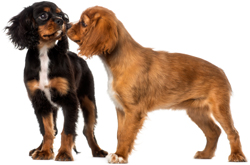 Perhaps you wish to set up a play date with your dog and a friend’s dog, or maybe you’re bringing home another canine to grace your household. Both require proper doggy introductions! Simply thrusting two dogs together in one home or one backyard is a recipe for disaster, as is allowing two dogs to meet while on leash. Make safety a priority and success your goal in allowing your dog to meet unknown canines so he can have some doggy playmates and best friends!
Perhaps you wish to set up a play date with your dog and a friend’s dog, or maybe you’re bringing home another canine to grace your household. Both require proper doggy introductions! Simply thrusting two dogs together in one home or one backyard is a recipe for disaster, as is allowing two dogs to meet while on leash. Make safety a priority and success your goal in allowing your dog to meet unknown canines so he can have some doggy playmates and best friends!
Neutral Territory!
Ever wonder why dog parks work so well? It’s because no one dog owns the park! In fact, most dogs will only see the dog park once or twice a week and thus they have no claim to it as they would their own backyard that they potty in daily. This makes the dog park neutral territory. While you do not need to use a dog park for introductions, you do need neutral territory to get things started right! This means no back yards, no houses, and no routes in which either dog walks on daily.
The best way to find neutral territory is to think of a place that neither dog has gone to and is safe to have them off leash. The safest place will be fenced in so that the dogs can interact unhindered by tangled leashes. Bring along a tall puppy playpen that a dog cannot get out of, and it’s time to let introductions begin.
Using the Playpen
The use of the playpen is a safety measure. Put one dog in the playpen and the other is allowed to walk around it. The dog scan sniff each other, interact together, and even try to play but cannot touch each other. It gives you the chance to read both dogs’ body language to better understand if the two together would be a good match and get along.
When a playpen does not work, you can walk one dog on leash outside of a fence with the other dog off leash on the inside of a fence. The downfall to this is that with one dog on leash reactions may not be the same. Some dogs will feel tension in the leash, from the handler holding too tightly, and begin to react as they feel the human’s emotions rising. On the other hand, if the leash is too loose and the dog gets excited he may become tangled and injured in the leash’s slack. If you do introductions on leash, be prepared to have more hands on control than if they dogs were not leashed. Aside from reading the dogs’ behavior, you must also keep a constant eye on the leash itself.
Reading the Dogs
The entire purpose of introductions is to let dogs get to know each other in a stress free, non-threatening way. Neutral territory means no one dog will push around the other based on resources. Keeping resources out of introductions also means no toys, treats, food or water should be made available in the beginning until you know if the two dogs will get along.
Behaviors you should watch out for that may mean failure is a stiffened body, hackles raised, growling and a straight tail. Standing on toes, raising lips and aggressive barking are all bad signs. A dog who does these things is trying to say, “I don’t like you! Get away from me!” The behavior you can hope for is a loosely wagging tail, play bow positions, lots of sniffing and even rolling over. These acts tell the other dog “I’m not here to cause trouble, and I am harmless. Want to play?” When the dogs seem relaxed and interested in each other, you can remove the playpen and keep a close eye on their interactions. Most dogs will happily play together without any problems, but never let your guard down!
Keep in mind that not all dogs will get along. Just like people, some dogs just don’t like certain other dogs! Some dogs have a more pushy personality while others are very easy going and laid back. Some dogs may be too energetic for another dog to handle. With each canine being an individual, knowing the dogs’ personalities is key in matching a pair that will get along and play together. Avoid putting two dogs with dominating personalities together to prevent conflict, and always respect your dog’s comfort levels. With these ideas in mind, you are sure to find our own best friend a canine buddy.
Visit Pampered Paw Gifts To Find Toys and Treats For Your Dog